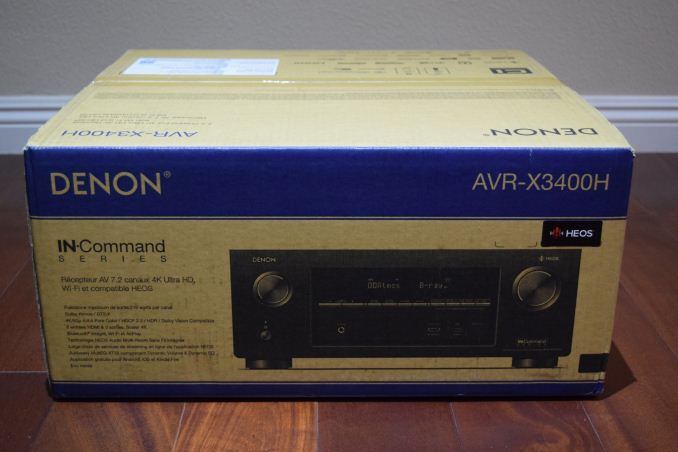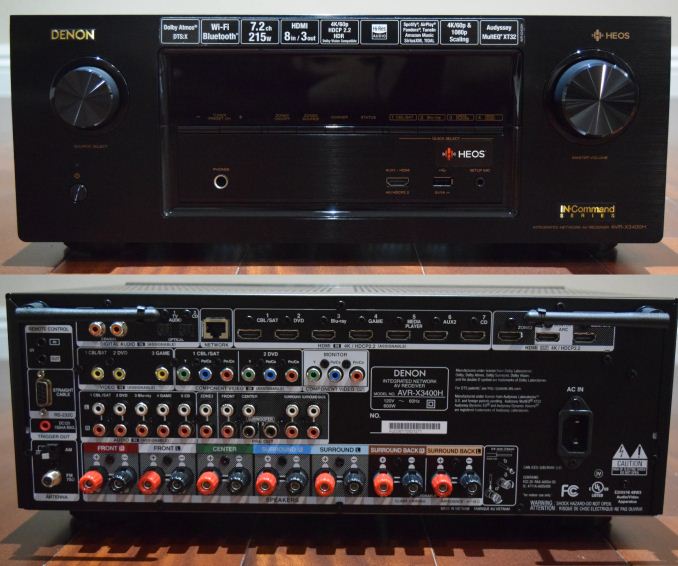A Budget Home Theater & PC Setup: 4K, HDR, UHD Blu-ray, and More
by Ganesh T S on December 26, 2017 8:30 AM ESTThe AVR: Denon X3400H
The choice of AVRs used to be a difficult one to make when support for different HD audio formats was not widespread. Now, the requirements boil down to the AVR being able to support the latest HD audio formats (Dolby Atmos and DTS-X), while matching the capabilities of the display in the chain. The additional features may help sway the purchase decision for consumers.
Budget considerations dictate the number of channels and display zones. We had to migrate from the 7.1 channel Pioneer Elite VSX-32 to a newer receiver capable of handling multiple HDMI 2.0 / HDCP 2.2 inputs with passthrough capabilities for various HDR formats. Based on my budget, I narrowed down the options to one of the models from Denon, Onkyo, Pioneer, and Yamaha. They are all in the same ball park in terms of pricing for a given feature set. We deferred to our friends at Wirecutter, who recommended the Denon AVR S730H.
I had been in touch with Denon regarding HEOS (their whole home audio solution) when the decision to go with a Denon AVR for our HTPC testing setup was taken. Upon discussing our project with them, Denon graciously agreed to sponsor the more advanced AVR X3400H for use in our testing.
The AVR X3400H targets the custom integrator channel. It has a number of additional features such as support for high end DSD audio, 4Kp60 upconversion for analog sources, multi-zone video outputs, higher power output, and support for eARC (Enhanced Audio Return Channel) to justify its higher price over the S730H. The presence of eARC makes it a bit more future-proof, as it allows for HD audio (including the new ones like Dolby Atmos and DTS-X) from the display sink to be returned to the AVR for decode and playback.
In the course of our testing, we found that the AVR received frequent firmware updates to add new features such as HLG passthrough. These point to a well-supported product. Even though the web control feature present in the previous generation Denon AVRs was missed, the Denon AVR Android app made up for it to some extent. None of the issues encountered in the course of the evaluation presented in this piece could be attributed to the Denon AVR X3400H.
If we had to give some suggestions to Denon for the improvement of the AVR X3400H, it would be to bring back the web control feature and shorten the time taken for firmware updates (though there is a facility to enable auto-updates that tries to install the new firmware when the AVR is not being used).
Speakers
Most readers upgrading their HTPC can opt to retain their existing speakers. In fact, I had the Boston Acoustics Horizon Series MCS100MDNT 5.1-channel speaker system from a 2008 purchase, along with a Jamo A306 HCS 5.1 speaker system from my 2011 home theater components upgrade. However, due to the remodel, I had to go in for in-ceiling speakers. I opted for a couple of the Polk Audio RC80i in-ceiling pairs for the rear and surround channel speakers. I bundled them along with ceiling speaker protective covers. The choice of speakers depends on the home theater size and other requirements. Currently, I am using the Jamo A306 speakers for the front, center, and subwoofer, with the Polk Audio RC80i for the other channels.












191 Comments
View All Comments
pjcamp - Wednesday, December 27, 2017 - link
The one thing you didn't mention is what keyboard you are using. I haven't been happy with any of the ones I've used so a little help would be, well, helpful.DIE_BETA_SOY_BOYS - Wednesday, December 27, 2017 - link
"budget"What a useless article
watersb - Wednesday, December 27, 2017 - link
I, for one, enjoyed this write-up very much. I have been out of the AV Zone for a decade, but as a musician and PC enthusiast I was curious to see how this played out.A write-up like this: I have done similar tests for audio-only gear, and it took 50 hours of work. Maybe I'm too slow.
And finally, this may be a dumb question, but for a Home Theater setup, what keyboard/pointing device work best for you? I need to get something. My ten-year-old Gyration Mouse/keyboard has died. Not kidding. It was great. Backlit keyboard that can see duty as primary PC keyboard preferred.
What are you all using?
Shaan1969 - Thursday, December 28, 2017 - link
watersb, Logitech K830 (~$50) is the best one with long lasting rechargeable battery with back-lit option. I have been using it for the last few years without any issues.watersb - Tuesday, January 2, 2018 - link
Thanks! Was on my list, at $50 the price has come down a bit since last I looked.Shaan1969 - Thursday, December 28, 2017 - link
Ganesh, thank you for taking time to write up a great article. I thoroughly enjoyed reading it and planning to upgrade my HTPC accordingly this weekend.Everyone's definition of budget is different and I wish readers focus on the content of the article rather than accusing the writer.
milkod2001 - Thursday, December 28, 2017 - link
good read, you might want to also upgrade those curtains granny bought and insisted to use when on last visit while you are in this upgrading process.UtilityMax - Friday, December 29, 2017 - link
This situation with the high cost and pain-in-the-butt involved in 4K HTPC setup compared to buying Playstation 4, Xbox, or Roku reminds me of a similar situation that happened with home routers in the late 1990s. As the Internet connections started becoming more affordable (be it dialup or broadband) a whole lot of geeks wanted to come up with solutions so that their entire home network could connect to the internet with just one IP address. A whole lot of them turned to setting up a dedicated PC running Linux to act as their gateway to the internet for the purpose of firewalling and network address translation (NAT). This made even people originally not interested in using Linux start exploring the Linux systems because back in the 1990s Linux distributions were way better than Windows or Macs at advanced networking stuff.Then an interesting thing happened. A cheap Taiwanese-made router with firewall, NAT, and a 4-5 port 100Mbps switch became available for something like 50 bucks around year 1999-2000. This has near instantly killed the concept of setting up manually a dedicated PC to act as your router gateway. Today you don't even have to buy a dedicated router, because your broadband cable modem probably already comes integrated with wifi, router, NAT, firewall, switch, and all that (mine does).
The same way we are observing the situation where various set top boxes or "sticks" costing under a couple of hundred bucks, gaming consoles, and even smart TVs have pretty much near eliminated the whole point of building a dedicated HTPC. HTPC is basically a dinosaur.
Combine that with the fact that most people out there still don't give a damn about 4K content, don't have 4K TVs, don't have access to 4K cable (duh!), and don't want to pay for either 4K BD discs or for high speed internet conections required for 4K streaming, and you see why building your own HTPC is going to be just like banging your head against a wall.
rapster - Friday, December 29, 2017 - link
Totally agree. The NVIDIA Shield has - for me - made the PC moot. This time around I based my system on a Shield that streams from the internet and Synology disk array, a “budget” receiver, a BD player, some great speakers, and an old 1080p TV. Not even sure what use a PC would serve.mikato - Thursday, January 18, 2018 - link
Sounds good. I’ll have to check out the Shield. But you can’t bring this to a friend’s house and plug into their TV or home theater. I want that too :)